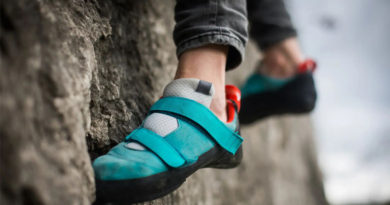Mountain Climbing vs. Hiking: What’s the Difference?
Mountain climbing and hiking are both outdoor activities that involve physical exertion. However, there are some fundamental differences between these two activities. Mountain climbing is a more strenuous and risky activity. It involves scaling steep and often vertical rock formations or peaks. You do this with the aid of technical equipment such as ropes, harnesses, and carabiners. Hiking, on the other hand, involves walking or trekking through rugged or hilly terrain. It does not often require specialized gear or technical skills. Hiking is often less strenuous and risky than mountain climbing, and it focuses on exploring and enjoying nature.
In the following article, I will further explain the differences between these two activities. So keep reading to learn more.
Difficulty Level
Mountain climbing, often known as mountaineering, is regarded as more challenging than hiking. Mountaineering often requires technical skills and equipment such as ropes, harnesses, and carabiners to ascend steep and often vertical rock formations or peaks. You must be physically and emotionally prepared for the difficulties and dangers connected with high-altitude mountaineering. These dangers include severe weather, avalanches, and altitude sickness.
In contrast, hiking is often less hard and less risky. It concentrates on discovering and appreciating nature rather than rising to the pinnacle of a peak. The difficulty of both activities can vary substantially depending on the terrain, conditions, and the participant’s physical and mental preparedness.
Equipment Required
There is a substantial difference in equipment between mountaineering and hiking. Mountaineering often requires the use of specialized equipment. It includes ropes, harnesses, carabiners, climbing shoes, and other technical gear. This equipment assists climbers in safely scaling steep and quite often vertical rock formations or peaks. This equipment keeps climbers safe from falls. It offers a strong anchor as they progress up the mountain. Mountaineers generally carry specialist clothes, such as waterproof and insulating layers, in addition to technical equipment to help protect them from the elements at high altitudes.
Hiking, on the other hand, often requires far less specialized equipment. Hikers often only require comfortable, supportive footwear, weather-appropriate clothing, and a small backpack to carry food, water, and other essentials. Hikers may also take extra equipment such as a map, compass, and GPS gadget if they are hiking in remote places.
Finally, the type of equipment required for mountaineering and hiking is heavily dependent on the activity and terrain. While mountaineering requires more sophisticated equipment, you can hike with less gear. However, both mountaineers and hikers must always wear suitable gear and equipment for the weather. So prepared for the unexpected.
Destinations
Mountaineering often involves scaling steep and often vertical peaks with the ultimate goal of reaching the summit. Mountaineers may travel to distant, high-altitude places such as the Himalayas, the Andes, or the Alps to test their abilities and stamina, as well as to experience the pleasure of climbing. Mountaineering destinations are often chosen based on the difficulty of the climb and the unique obstacles they provide, such as sheer rock faces, ice formations, and exposed ridges.
Hikers, on the other hand, often pick destinations for the beauty of the natural environment and the possibility of discovery. You can enjoy the beauty, wildlife, and peace & quiet by traveling to alpine regions, woods, or seaside places. Hikers usually choose destinations based on their accessibility, scenic attractiveness, and level of difficulty. Depending on their experience and fitness level, hikers can choose to explore well-trodden pathways or take on more difficult ones.
Finally, both climbing and hiking provide a diverse choice of sites that cater to a variety of interests, skills, and degrees of expertise. Scaling steep hills or exploring scenic paths allows participants to connect with nature, push themselves, and enjoy the beauty of the outdoors.
Purpose
Mountaineering is often seen as a challenge and a test of physical and mental endurance. Climbers strive to reach the summit of a peak and push themselves to their limits. For many mountaineers, the act of climbing is its own reward, as it provides a sense of accomplishment and a unique connection with nature. Mountaineering is also seen as a way to explore remote and beautiful regions, experience unique environments, and test one’s limits.
In contrast, hiking is often seen as a leisure activity, a means to discover and take in the natural world. Hikers may set out to explore beautiful trails, appreciate their surroundings, or establish a connection with nature. In addition to being a type of exercise, you can utilize hiking to reduce stress and increase physical fitness. Hiking is a popular pastime that many people use to unwind, spend time with loved ones, and simply appreciate nature.
Mountain climbing and hiking each has distinct objectives and benefits. Both activities enable individuals to connect with nature, challenge themselves, and take in the beauty of the outdoors, whether it’s the strenuous task of ascending a peak or the peaceful exploration of a scenic trail.
Risk and Safety
Mountaineering involves much higher risks and dangers, as climbers are often scaling steep and often vertical rock formations or peaks in remote, high-altitude regions. Climbers face risks such as falling, exposure to bad weather, avalanches, and altitude sickness. You need to prepare for the potential dangers and must have the technical skills and gear necessary to protect yourself and your climbing partners.
Hiking, on the other hand, often involves lower risks and dangers because hikers typically explore well-established trails in lower-altitude regions. Hikers may still face dangers such as becoming lost, coming into contact with wildlife, or being exposed to severe weather. Although these risks are normally much smaller than those associated with mountaineering. Hikers can usually reduce their hazards by adequately planning for their trip. They carry appropriate clothing and gear and adhere to designated trails and safety protocols.
Conclusion
Mountain climbing and hiking are two different outdoor sports that provide unique experiences and challenges. Mountain climbing is more perilous, requiring technical skills and specific equipment to scale high peaks with the ultimate goal of reaching the summit. Hiking, on the other hand, is a recreational activity that involves exploring well-established trails while taking in the natural environment. The destinations, purposes, and risk and safety concerns of these two sports are vastly different, with hiking normally being less dangerous and accessible to a broader range of people. Before starting any outdoor excursion, it is critical to fully prepare and recognize the hazards inherent in both activities.




